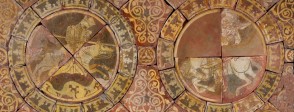The Richard and Saladin tiles are a ready-made jigsaw. Print and cut up the tiles along the lines separating individual pieces. Students can work in pairs to do the jigsaw. This will force them to look carefully at the tiles and to begin discussing the different elements.
When students have completed the jigsaw they can play a ‘think of a question’ game in teams of 4 or 5. Each team has a completed jigsaw or whole picture, if you prefer, a dice, a large sheet of paper and a marker pen. Within each team, students take it in turns to shake the dice and to think of a good question about the tiles beginning with the question word linked to a particular number: 1. What, 2. When, 3. Where, 4. Who, 5. How, 6.Why. Ask teams to pick their most interesting question and share these on the whiteboard. Then switch the focus to answering the questions. Are students certain about the answers to any questions? Can they make some good guesses about others?
Tell students the story of the tiles: what they are, where they are from, what they show. Briefly explain who Richard and Saladin were and what happened on the Third Crusade. Explain that Richard and Saladin never met each other face to face. Tell students that after 1192 we find lots of images of Richard I spearing Saladin with his lance – in manuscripts, on wall paintings as well as on tiles. Look at the example from a manuscript in For the classroom. Can students suggest a reason for the use of this image?
Compare the Chertsey tiles with the two examples of combat scenes made by Muslim artists in For the classroom. Which of the Muslim examples is most similar to the Cherstey scene?
Explore other famous examples of tiles from medieval England. Search the British Museum website for tiles from Byland Abbey and for the Tring tiles. Compare these with the Chertsey tiles. Find out more about the use of tiles, their cost and the industry of tile-making.
The title page of Fuller’s Historie of the Holy Warre in For the classroom offers an opportunity to study how the Crusades were represented in the AD 1600s. The images and inscriptions are quite legible and easy to make out.
The Richard and Saladin tiles can be incorporated into different enquires on the Crusades:
Does Richard I deserve to be remembered as a great crusader?
Start with the tiles, then introduce students to different images of Richard I from the middle ages to the 12th century, all of which portray Richard as crusading hero – there are two examples in For the classroom. Challenge students to study the events of the Third Crusade and to make their minds up about Richard: how far was he the great crusader portrayed in the images? The enquiry could be structured around: 1. Richard’s background and his decision to take the cross in 1187; 2. the preparations Richard made for the crusade including the Saladin Tithe and his decision to travel by sea; 3. his journey to the Holy Land; 4. the Siege of Acre, march to Jaffa and battle of Arsuf; 5. Richard’s attempts to recapture Jerusalem. Students can collect ideas on a great crusader/bad crusader grid as they study the Third Crusade. The enquiry could conclude with a debate or a discursive essay.
Challenging simplified history: what made the Crusades so complex?
Incorporate the Richard and Saladin tiles into a broad enquiry which introduces students to the crusades and requires them to explore the complexities of this period of history. Structure your students’ study of the Crusades in chronological stages introducing each stage with the statements given below.
1. The motivation of the first crusaders: People joined the First Crusade to become rich
2. The First Crusade: The First Crusade succeeded because it had strong leaders
3. Life in the crusader states: Muslims and Christians in the crusader states were always in conflict
4. The Third Crusade: Richard I was a great crusader
5. Crusades of the 13th century: The crusader states ended because of Baybars
Ask student to response to each statement with “That’s too simple!” They can then write paragraphs challenging each simple statement as they move through the enquiry.
The crusader states: melting pot, medieval apartheid or messy mixture?
In this enquiry students investigate the nature of the society that emerged in the crusader states during the 12th century, and, in particular, the ways in which Muslims and Christians related to each other. Did the westerners mingle harmoniously with the indigenous population of eastern Christians and Muslims? Did they live separately using their laws and military force to oppress the Muslim population? Or was the reality more a combination of assimilation and segregation? Students could investigate these issues by studying settlement patterns, crusader castles, trade, the writing of Usama ibn Munqidh and architecture. There could be a particular focus on works of art such as the Melisende Psalter and some of the objects in A bigger picture.


